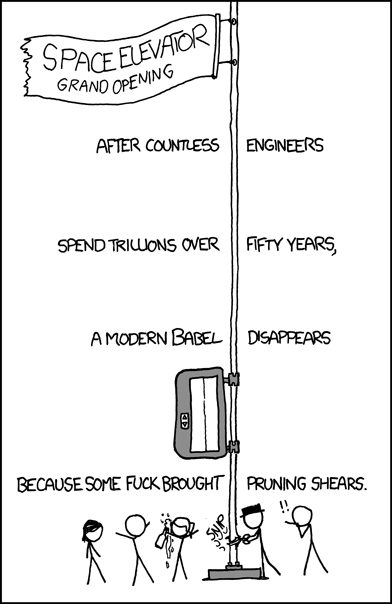Image credit
To date, most of the ideas proposed for transportation of things from Earth's surface to space have attacked the problem with speed. Accelerate one way or another to about 8 kilometers a second of sideways speed, and it's easy to stick around in space. There's another way to get there, by going up rather than fast. Space elevators are proposed megastructures that allow payloads to be slowly transported upward from a planet's equator to planet-stationary orbit, and you can read more about them here:
Space elevator
On Earth the geography is a little limiting, since geostationary orbits can only be achieved over the equator, and the vagaries of geopolitics have led the set of countries with space programs to have almost no commonality with the set of countries that lie on the equator. That's not a big deal, though, compared to the technical challenges that remain, and some proposals have worked this problem by imagining the tether extending down to a mobile ocean-going barge rather than a fixed ground station. While there are some political issues that remain with the basic concept, such as who's responsible if the cable breaks and crashes into the equatorial countries, or who's in charge of defending it from terrorism and orbital debris, but the technical hurdles that remain make these look like child's play.
First, there's the strength problem. The only material known to chemical engineering that has the strength necessary to keep a tether intact all the way form Earth's surface to 36,000 kilometers up is carbon nanotube, a peculiar carbon allotrope that's difficult to manage in macroscopic quantities. When the best way people can think of to handle a material is by grabbing it with scotch tape, it's probably a long way from megameter-long ribbons. Interestingly, although a tether from the L1 Lagrange point to the surface of the Moon would be much longer than one from Earth's surface to GEO, because the Moon's gravitational pull is so much less than Earth's, presently workable materials like Kevlar could be used to make a lunar space elevator. Too bad nobody lives on the Moon.
There are also major controls and other practical issues that are often overlooked by elevator enthusiasts. How do you keep a 36,000+ kilometer-long tether going the right direction with no friction to damp things out during the deployment phase? How do you moderate the Corriolis acceleration that elevator cars induce on the tether? How do you power the cars? How heavy does the radiation shielding on the cars need to be, given their slow passage through the Van Allen belts? The idea is physically plausible, but these concerns need to be addressed. My engineer's intuition is that overcoming the design challenges in the way of low cost reusable rocket-propelled vehicles is a much less difficult task than overcoming the basic material, controls, power, and political problems of the space elevator.
That said, the concept has many fans, among them Randall Munroe of xkcd fame. Perhaps one day his camp will be vindicated. We'll see, but I know where my bet is.


No comments:
Post a Comment